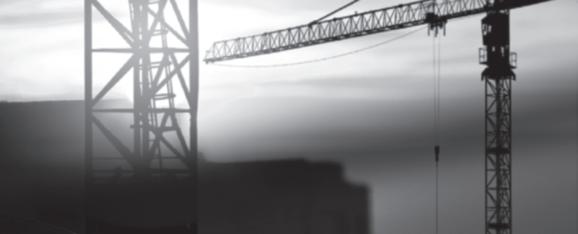
6 minute read
Rehiring and COVID
Build season is upon us, and responses from AGC’s 2021 Construction Outlook National Survey show 54 percent of those surveyed said they are having a hard time filling some or all positions, even with increased base pay rates and incentives. When asked to identify which issues are the biggest concerns to their firms, 43 percent of respondents listed worker shortages and 40 percent despaired of worker quality. AGC says overall, 35 percent of its respondents anticipate adding more people to their company’s headcounts this year and 41 percent plan to keep their headcounts as is. Comparing union and open shop hiring, only one-quarter of union employers expect REHIRING AND Today’s COVID world requires new metrics for measuring a job candidate’s potential. COVID When hiring, companies need to balance a worker’s or job applicant’s skills with his or her usefulness to the company. @ KZENON - ADOBESTOCK.COM BY GEORGIA KRAUSE to increase their headcount, with 36 percent

OSHA agencies are defining their own guidance. See California’s Act Now Advisory and Pennsylvania’s Guidance to @ JU PHOTOSTOCKER - ADOBESTOCK.COM the Construction Industry for examples.) This year also presents changes in the available labor pool configuration. The Wall Street Journal recently wrote, “The Coronavirus pandemic is forcing the fastest reallocation of labor since World War II.” Workers who initially thought they would return to their pre-pandemic jobs are finding those anticipating jobs have disappeared. This presents both a reduction. a conundrum as well as an opportunity for Open shops seem employers looking to fill positions this year. more optimistic This is a time for changing our hiring with 40 percent reporting they expect to add employees and only 18 percent expecting a decrease Cue the pandemic. The AGC survey also says 84 percent of survey respondents list the pandemic’s impact on projects, workers, and supply chains as their number one concern. AGC’s survey cites COVID mitigation issues, infection risks from nonemployees spreading to jobsites, and questions about inadequate legal protection against unwarranted virus-related claims from worksites. (OSHA continues to be the national resource for COVID employer/ employee protocols; however state @ ETAJOE - ADOBESTOCK.COM

perspectives. COVID has pushed many good, skilled workers out of their jobs through no fault of their own. The old metrics for measuring a job candidate’s potential, as well as entrenched corporate directives, hinder finding valuable employees in 2021.
Don’t assume that a laid off or furloughed worker is now a past employee. Assumptions that the worker has moved on or has taken another job limit the labor pool available to you. HR experts are finding that COVID-displaced workers are overlooked or forgotten. Some may have taken ‘bridge’ jobs to get through the pandemic but are still a good fit for your now open position. Ask them. And, if your company has a no rehire policy, get over it.
As for workers still hanging in with you, in a previous AEMP post, AEMP CEO Donte Shannon talked about ‘tapping someone on the shoulder’ to get them to participate in jobs they may not have seen as a good fit for themselves. Now is the time to talk with current and furloughed employees about transferring their skills to other positions within your company. Monster’s 2021 Future of Work Survey says the top four most important skills employers are looking for are dependability, teamwork/ collaboration, problem solving/critical thinking, and flexibility — valuable assets that an employee may have demonstrated well before. Consider tapping the shoulder of a current or past worker and investing in some additional training and transferring those assets to an open position in your company. Training a recently furloughed worker eliminates the need for extensive new-hire onboarding and cultural alignment.
This hiring season, balance the worker’s or job applicant’s task skills with his / her usefulness to your company. A solid knowledge of the industry and your company in particular are directly related to Monster’s top four most important skills.

@ IQONCEPT - ADOBESTOCK.COM
“What we’ve got here is failure to communicate.” - Cool Hand Luke
Is it us? Could it be we as an industry aren’t doing a good enough job of communicating to potential employees that a career as a diesel tech is time well spent? According to research done by ZipRecruiter, there is a gap between what employers say they are looking for to fill a job and what job seekers think employers want. In some cases, that gap becomes a pothole that impedes good jobs from finding good workers.
The ZipRecruiter comparison highlighted two fairly simple issues that are problematic in the current hiring process. While it is up to the job applicant to provide documentation of work experience as it applies to the job opening, if hiring managers are not explicit enough in their job posts about exactly the skills, experience, and qualifications they are searching for in a new hire, the applicant is already at a loss. Additionally, if the job post doesn’t detail the job’s tasks, a potentially great hire will simply pass to the next job posting.
Let’s talk diesel technicians. The ZipRecruiter comparison showed key features such as having a CDL license, ASE diesel or AEMP CEM certifications, and telematics experience useful for diesel technicians weren’t mentioned in either the job descriptions posted by employers or offered in the respondent’s resumes. Both hiring managers and job applicants assumed the other understood the job’s day-to-day responsibilities included these assets. The result was a missed opportunity.
A job post that says, “Diesel Technician will identify and resolve potential defects of off-road earthmoving equipment by troubleshooting, conducting preventive maintenance, and calibration procedures using OEM and leading aftermarket test equipment” tells the applicant not only what the job is but also indirectly says the company works with specific equipment, probably leaning towards one brand, has embraced technology and trusts the tech work within set parameters. AI startup firms like Textio can help hiring managers build better job postings that give the job description the detail and voice required to interest an applicant.
Now, blame the algorithms. In the old days, hiring managers posted open positions in newspapers and job seekers responded by phone, in person, or by letter. Sometimes we’d get lucky and a recruiter or another employer would send us a lead and referral. The common denominator was the opportunity to make human contact.
Today approximately 38 percent of medium size firms and more than 70 percent of large companies use applicant tracking (ATS) forcing job seekers to maneuver around qualifiers such as knockout questions that crunch the application data and rates everything from keywords and data tags to punctuation. With luck the applicant’s digitals tickle a preexisting ratio of positive matches which then allows the computer to forward the applicant’s resume to a human. Job applications that are one match short go right to cyber hell. No human contact, no chance at a job match.
ATS prepackaged programs organize job seeker’s based on experience and skill sets but used right off the shelf they don’t reflect the filters specific to our industry. If you use AI or ATS screening software, work with your vendor or recruiter to fine tune the filters to best reflect what you are looking from the audience you are reaching. Susan Alvarez, a transportation recruiter interviewed in a previous AEMP article, says employment software often does a much better job of screening out than pulling in. “You must communicate with the applicant at a common point that fits you both.”
Catch more applicants with a broader net. It might seem like more effort, but you’ll have a better chance to catch the right applicant.


IGNITE YOUR CAREER.














